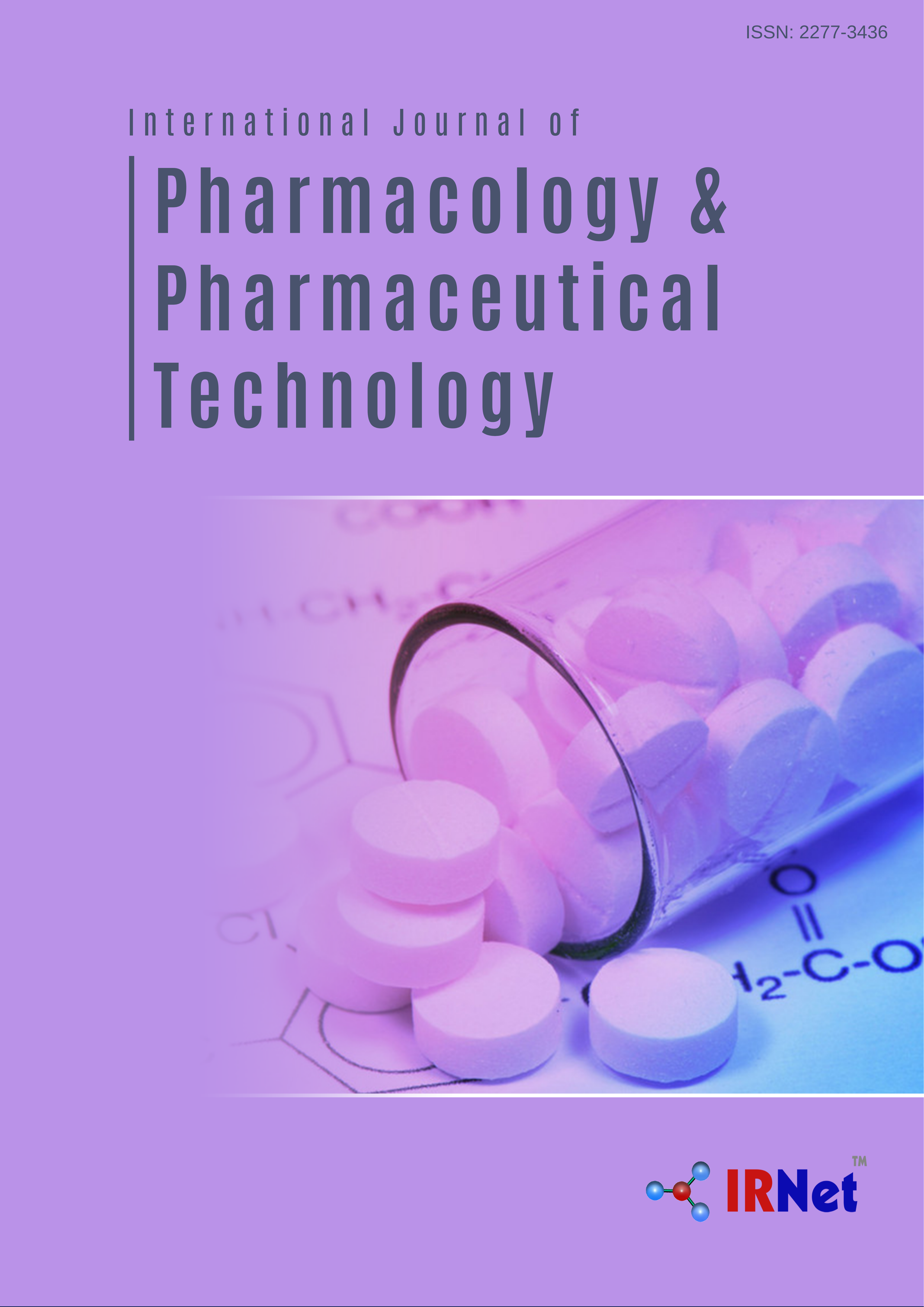International Journal of Pharmacology and Pharmaceutical Technology IJPPT
ISSN: 2277-3436

Abstracting and Indexing


IJPPT
Poly (PEGDMA-MAA) copolymeric micro and nanoparticles for Poly (PEGDMA-MAA) copolymeric micro and nanoparticles for oral insulin delivery : A molecular mechanistic revisit
Lomas Tomar
University of the Witwatersrand, Faculty of Health Sciences, Department of Pharmacy and Pharmacology, 7 York Road, Parktown 2193, Johannesburg, Gauteng, South Africa
Charu Tyagi
Vijay Singh Pathik Govt. (P.G.) College, C.C.S. University, Meerut-250004, U.P., India
Pradeep Kumar
University of the Witwatersrand, Faculty of Health Sciences, Department of Pharmacy and Pharmacology, 7 York Road, Parktown 2193, Johannesburg, Gauteng, South Africa
Yahya E. Choonara
University of the Witwatersrand, Faculty of Health Sciences, Department of Pharmacy and Pharmacology, 7 York Road, Parktown 2193, Johannesburg, Gauteng, South Africa
Lisa Du Toit
University of the Witwatersrand, Faculty of Health Sciences, Department of Pharmacy and Pharmacology, 7 York Road, Parktown 2193, Johannesburg, Gauteng, South Africa
Viness Pillay
University of the Witwatersrand, Faculty of Health Sciences, Department of Pharmacy and Pharmacology, 7 York Road, Parktown 2193, Johannesburg, Gauteng, South Africa
Abstract
Poly(ethylene glycol) dimethacrylate (PEGDMA) and methacrylic acid (MAA) based micro and nanoparticles were prepared for oral insulin delivery. The reactional profiles of MAA, PEGDMA and PEGDMA-MAA were elucidated using molecular mechanics energy relationships (MMER) in vacuum and in a solvated system by exploring the spatial disposition of different concentrations of polymers with respect to each other. Furthermore, the incorporation of insulin within the polymeric matrix was modeled using connolly molecular surfaces. The computational results corroborated with the experimental and analytical data. The ability to effectively control blood glucose level coupled with the non toxic behavior of the nanoparticles renders them a potential candidate for insulin delivery.
Recommended Citation
1. S. V. Sastry, J. R. Nyshadham and J. A. Fix, “Recent technological advances in oral drug delivery - a review,” Pharm. Sci. Technol. Today, vol. 3, Apr. 2000, pp. 138-145. 2. M. Mesiha, F. Plakogiannis and S. Vejosoth, “Enhanced oral absorption of insulin from desolvated fatty acid-sodium glycocholate emulsions,” Int. J. Pharm., vol. 111, 1994, pp. 213 216. 3. M. A. Radwant and H. Y. Aboul-Enein, “The effect of oral absorption enhancers on the in vivo performance of insulin-loaded poly (ethylcyanoacrylate) nanospheres in diabetic rats,” J. Microencapsul., vol. 19, 2002, pp. 225–235. 4. I. Morishita, M. Morishita, K. Takayama, Y. Machida and T. Nagai, “Hypoglycemic effect of novel oral microspheres of insulin with protease inhibitors in normal and diabetic rats,” Int. J. Pharm., vol. 78, Jan. 1992, pp. 9-16. 5. T. Kimura, K. Sato, K. Sugimoto, R. Tao, T. Murakami, Y. Kurosaki and T. Nakayama, “Oral administration of insulin as poly(vinyl alcohol)-gel spheres in diabetic rats,” Biol. Pharm. Bull, vol. 19, Jun. 1996, pp. 897-900. 6. C. Damge and H. Vranckx, “Poly(alkyl cyanoacrylate) nanospheres for oral administration of insulin,” J. Pharm. Sci., vol. 86, 1997, pp. 1403 1409. 7. M. K. Marschutz and P. Caliceti, “Design and in vivo evaluation of an oral delivery system for insulin,” Pharm. Res., vol. 17, Dec. 2000, pp. 1468 1474. 8. H. Takeuchi, H. Yamamoto, T. Niwa, T. Hino and Y. Kawashima, “Enteral absorption of insulin in rats from mucoadhesive chitosan-coated liposomes,” Pharm. Res., vol. 13, Jun. 1996, pp. 896-901. 9. J. Y. Lee, P. C. Painter and M. M. Coleman, “Hydrogen Bonding in Polymer Blends. 3. Blends Involving Polymers Containing Methacrylic Acid and Ether Groups,” Macromolecules, vol. 21, 1988, pp. 346–354. 10. L. K. Tomar, C. Tyagi, S. S. Lahiri and H. Singh, “Poly(PEGDMA-MAA) copolymeric micro and nanoparticles for oral insulin delivery,” Polym. Adv. Technol., vol. 22, Dec. 2011, pp. 1760–1767. 11. P. Kumar, V. Pillay, Y. E. Choonara, G. Modi, D. Naidoo and L. C. du Toit, “In silico theoretical molecular modeling for Alzheimer’s disease: The nicotine-curcumin paradigm in neuroprotection and neurotherapy,” Int. J. Mol. Sci., vol. 12, Jan. 2011, pp. 694-724. 12. D. C. Warhurst, J. C. Craig, I. S. Adagu, D. J. Meyer and S. Y. Lee, “The relationship of physico chemical properties and structure to the differential antiplasmodial activity of the cinchona alkaloids,” Malaria J.,vol. 2, Sep. 2003, pp. 26-39. 13. D. A. Pearlman, D. A. Case, J. W. Caldwell, W. S. Ross, T. E. Cheatham, S. De-Bolt III, D. Ferguson, G. Seibel and P. Kollman, “AMBER, a package of computer programs for applying molecular mechanics, normal mode analysis, molecular dynamics and free energy calculations to simulate the structural and energetic properties of molecules,” Comp. Phys. Commun., vol. 91, 1995, pp. 1-41. 14. W. Guo, Y. Guo, H. Gao, Q. Zheng, and W. Zhong, “Energy Dissipation in Gigahertz Oscillators from Multiwalled Carbon Nanotubes,” Phys. Rev. Lett., vol. 91, 2003, pp. 125501-4. 15. B. Y. Yu, J. W. Chung and S-Y Kwak, “Reduced Migration from Flexible Poly(vinyl chloride) of a Plasticizer Containing β-Cyclodextrin Derivative,” Environ. Sci. Technol., vol. 42, Aug. 2008 pp. 7522–7527.